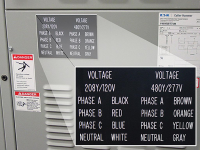Whether color differentiation is required by code or not, I'm confused as to why anyone would ask if the conductors could be all black. Why would anyone purposely not color them, regardless of whether they used the normal color convention or not. Just curious.
forget about having multiple voltage systems for the time being.
If you running a circuit to a balanced three phase load where input phase rotation doesn't matter, why do you care which phase is which?
Such loads might be three phase heater, a VFD or anything else that is immediately rectified to DC volts. None of those really matter what phase conductor goes where.
If running three such circuits in one raceway I'd rather use three blacks for one circuit, three reds, for one circuit and three blues for one circuit than to have to run one of each color per circuit then have to further identify which black/red/blue went with which circuit.


